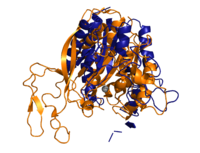Canavan Disease: Task 04 - Structural Alignments
Contents
LabJournal
Dataset
To gain the dataset as desired first a reference sequence (2I3C) was chosen. Then the dataset was generated using this sequence fulfilling the required criteria. The full composition and additional information can be found in <xr id="dataset"> Table </xr>. <figtable id="dataset">
| Dataset composition | |||
|---|---|---|---|
| PDB-id | Description | Criterium | |
| 2I3C | ASPA from Human | reference structure | |
| 2O4H | ASPA from Human with bound N-phosphonomethyl-L-aspartate | sequence identity 100% & bound active centre | |
| 2Q51 | ASPA from Human (Ensemble refinement) | sequence identity 100% & unbound active centre | |
| 2GU2 | ASPA from Rat | seq. identity >60% | |
| 2QJ8 | ASPA family protein from mesorhizobium loti | sequence identity <30% | |
| 1AYE | Procarbooxypeptidase from Human | similar CATH classification for CAT | |
| 1BKJ | FMN Oxireductase from vibrio harveyi | similar CATH classification for CA | |
| 1BD0 | Alanine racemase | similar CATH classification for C | |
| 1B3U | Regulatory domain of human PP2A | completely different CATH classification | |
</figtable>
Structural Alignment Exploration
Pymol
2O4H vs. 2I3C
2O4H was found via the sequence search tab for the reference sequence 2I3C. The structure was chosen due to the fact that it is contained in the 100% sequence identity cluster. Additionally it has a bound compound in the active center however it is not N-acetyl-L-aspartate, but N-Hydroxy(methyl)phosphoric-L-aspartate binding to the same active center.
Due to the fact that 2O4H and 2I3C have 100% sequence identity, the structural alignment via Pymol works very accurate. Both structures are within the bounds of the accuracy of X-ray crystallography the same. The RMSD between 2OH4 and 2I3C, calculated by the alignment process of Pymol is 0.341Å. As the measure for the divergence is smaller than possible to reach resulution of the structure they can be safely considered to be identical. The visual representation of the structural alignment is displayed in <xr id="2O4H_pymol">Figure </xr>. <figure id="2O4H_pymol">

</figure>
2Q51 vs 2I3C
<figure id="2Q51_pymol">
</figure>
2GU2 vs 2I3C
<figure id="2GU2_pymol">
</figure>
2QJ8 vs 2I3C
<figure id="2QJ8_pymol">
</figure>
Remaining Proteins
<figure id="Remaining_pymol">
</figure>
Comparison of SSAP, Topmatch, CE & LGA
Structural Alignment Evaluation
Tasks
- Link to Task 01: Canavan Disease
- Link to Task 02: Alignments
- Link to Task 03: Sequence-based Predictions
- Link to Task 04: Structural Alignments
- Link to Task 05: Homology Modelling
- Link to Task 06: Protein Structure Prediction from Evolutionary Sequence Variation
- Link to Task 07: Researching SNPs
- Link to Task 08: Sequence-based Mutation Analysis
- Link to Task 09: Structure-based Mutation Analysis
- Link to Task 10: Normal Mode Analysis
- Link to Task 11: Molecular Dynamics Simulation






